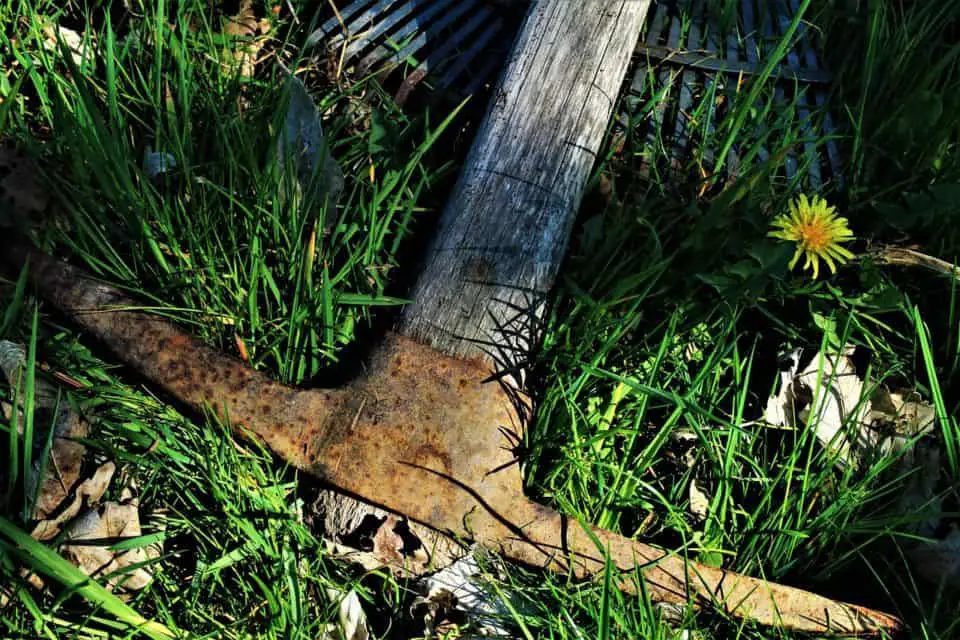Some links in the post are affiliate links and I get a commission from purchases made through some links found in the post.
What is a Cutter Mattock?
A cutter mattock, commonly known as a grub axe is a simple but effective tool frequently used in gardening practices. It is similar to a Pulaski or a pickaxe.
A mattock has a shaft made of wood and a head with two ends. It has a smaller vertical axe on one side and a longer horizontal adze on the other. This tool is used for digging, prying and chopping.
It is an ideal tool when attempting to cut through the roots or for digging the trenches.
Mattocks might be related to the rise of agriculture.
It is a two-in-one tool and thus comes in very handy. Another similar type of mattock is a pick mattock. It has a pick at one end instead of an axe.
Features of a Cutter Mattock
A mattock has a shaft made of wood for holding it. The shaft is about 4- 6 ft long. The cutter mattock’s head consists of two parts, an axe and an adze.
Both of these parts, opposite to each other, are separated by a central eye. The heads may vary which determine the kind and uses of the mattock. The head typically weighs about 3-7lb.
The axe is a vertical blade for cutting whereas the adze is a horizontal part for prying. Mattocks are the most versatile hand planting tools.
The adze is used to chop into the ground to pull the soil towards the user. The axe on the other hand is used to cut the roots and for removing stumps from the grounds.
How Do You Use a Cutter Mattock?
 The correct technique to use a cutting mattock is stated below:
The correct technique to use a cutting mattock is stated below:
- Grasp the handle or the shaft of the mattock halfway through its whole length. Place the other hand at its base. Always use the dominant hand to grab the shaft.
- Bend your waist a little with your back straight. Flex your knees with your feet shoulder-width apart. Make sure to put one foot slightly forward than the other.
- Now raise the mattock above your waist and let the weight of the head bring it falling onto the ground making an arc.
- Using small chops with the weight of the mattock itself will help save energy.
- To break up the soil and make a trench, use the handle as a lever to pull it with your arms, not your back.
- The adze is used for digging and prying. The axe, however, is used to cut the roots and for removing stumps.
- In the case of a pick mattock, the pick is used to break the hard soil and rocks. It is also used to dislodge the accumulated soil.
What are the Different Types of Cutter Mattock Head?
There are two kinds of mattock heads, a cutting mattock and a pick mattock.
Cutting Mattock
The cutting mattock features a vertical blade on one side and a horizontal blade on the other. The sharp vertical blade is the axe and is designed to cut twisted roots and stumps with ease.
The horizontal blade or adze is curved in structure helping it in penetrating and moving a greater amount of soil at a time.
Pick Mattock
The pick mattock has a long, tapered pick at one end instead of an axe thus combining a pick with an adze. The pick is used for digging up hard soil and for breaking rocks while the adze is used to dig the earth.
Claw Mattock
The claw mattock is another mattock head featuring an adze and two or three prolonged claws. These are commonly used to dig out weeds.
Hammer Mattock
The hammer mattock is another mattock head that features a hammer at one end and an adze on the other.
The adze can be used to cut and scrape up weeds in the garden while the hammer can come in handy for hammering a nail when needed.
If you are enjoying this article, you may enjoy our article on a dremel sharpening kit review.
What is the Difference Between a Pickaxe and a Mattock?
The terms pickaxe and the mattock are used alternatively; however, they are very different tools.
The mattock has a broader horizontal end called the adze with a vertical end, the axe on the other side. Also the mattock has a heavier head due to a broader adze.
The mattock with its heavier head provides greater momentum and allow the tool to dig and pry the soil with more ease. It allows the earth to be moved easily by using its shaft as a lever and pulling it towards yourself.
On the other hand, the pickaxe has a pick on one end with a narrow chisel at the other end.
The pickaxe has sharper and thinner blades on both ends. This T shaped tool is used for breaking up and splitting rocks and is more commonly used by miners although developed as an agricultural tool in prehistoric times.
Can you Split Wood with a Cutter Mattock?
The mattock has an axe to cut the roots and small stumps. However, its axe isn’t wide enough, is small in size and is too lightweight to cut woods.
It might cut some hard stumps but it is not a tool for splitting woods. Some may suggest sharpening it up to split the hard stumps.
But one must watch one’s leg which might get in the way while swinging the mattock. Thus, a Mattock isn’t a tool for this task.
Grinder cutters are usually preferred to split woods. Sometimes one might use an axe to cut and weaken a stump vertically.
Later on, a mattock is used to cut the weakened stump. However, undoubtedly the best tool for splitting wood is a chain saw or a grinder.
Final Thoughts
This prime farmer’s tool is a two in one gadget, the cutting mattock. It has a wooden shaft with two ends, an axe for cutting and an adze for digging and prying.
The heavier head provides momentum to perform these tasks efficiently. Mattock can be a cutting mattock or a pick mattock.
Both differ by having either an axe or a pick at one end. A pickaxe is a similar tool with a narrow chisel at one end.
However, you might want to choose a different tool than a mattock for splitting woods. Mattock is surely the best tool for digging, prying and chopping but not for splitting woods.
Before you go, here are some more related articles I encourage you to read below to help solve more of your gardening issues:
Can a Sickle Be Used For Weeding
About the Author:
Saad Ansar
Saad is an avid gardener himself and is a great lover of plants, animals, photography, & people. Currently, he is focused on photographing indoor plants & captioning beautiful outdoor sceneries. He writes and rewrites in-depth articles on nature and science.



